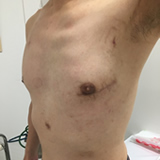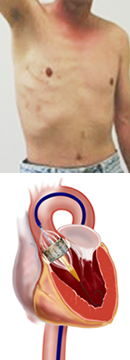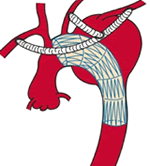- HOME
- Patient Care
- Clinical Department
- Cardiac Surgery
Cardiac Surgery
Overview of cardiac surgery team
The cardiac surgery service at IUHW Mita Hospital provides the various types of surgeries for coronary disease, valve disease, aortic disease and arrhythmias. The featured techniques include minimally invasive cardiac surgeries (MICS) for the variety of diseases. All surgeons are certified by the Japanese Board of Cardiovascular Surgery. Our team of highly experienced, compassionate professionals provide the specialized treatment using evidence-based approaches and are dedicated to caring of you with excellent communication skills in English. All of our medical staffs are at a master's level or above, and many hold doctorate and medical degrees from highly respected educational institutions.
Coronary artery bypasss grafting (CABG)
Coronary artery bypass graft surgery (CABG) is a procedure used to treat coronary disease. Coronary disease is a blockage of the coronary arteries– the blood vessels that supply oxygen and nutrients to the heart muscle. The limited supply of oxygen and nutrients to the heart may cause heart attack, and it may eventually lead to death. The best way to treat the condition is to bypass the blockage part(s) of the coronary arteries using piece(s) of healthy blood vessels taken from elsewhere in your body.
While the traditional CABG procedure is still commonly done by stopping the heart using a heart-lung machine, our technique of choice for coronary bypass surgery is the off-pump technique (Off-pump CABG or OPCAB), where a heart-lung machine is not used. This technique has been demonstrated to be less invasive than the traditional procedure, and offers several advantages to you: OPCAB reduces the chance of complications such as stroke, bleeding and organ dysfunction. As an even less invasive procedure, the team offers a minimally invasive-CABG technique which is performed through a small incision on the left chest, or a combination of CABG and a catheter-based intervention (so-called the "hybrid technique").

Valve surgery
In a healthy heart, valves open and close to ensure the proper one-way flow of blood through the heart. If your valve(s) have been damaged or diseased, they may not work correctly and cause a chance of heart failure.
- Open surgery: If possible, the damaged heart valve (most likely the mitral valve) is repaired to function better. If a repair technique is not possible or appropriate, the valve is replaced with a prosthetic valve. Our preferred technique is minimally invasive approach to heart valves through a small incision on the right chest.
- Catheter-based approach: The most popular valve disease is aortic stenosis, which is the narrowing of the exit of the heart. Although aortic valve replacement is the procedure of choice, open surgery may be likely to cause complications in high-risk patients such as very old people. We may offer you a procedure by which the aortic valve is replaced using a catheter-mounted prosthetic valve without using a heart-lung machine (trans-catheter aortic valve implantation, or TAVI).

Surgery for arrhythmia
Atrial fibrillation is a very common type of arrhythmia (an abnormal heat rhythm) which may cause clot formation in the atria. The clot may migrate into the head vessel and cause stroke. The type of arrhythmia is caused by electrical impulses in the atria. Maze procedure is named for the maze-like network of scars that is created on your heart muscle. The scars redirect the heart's electrical impulses, eliminating erratic impulses in the atria and restoring the heart's normal pumping function. These therapeutic scars can be made using an electromagnetic energy source. In addition, we close or remove the left atrial appendage, the major source of clot in the atria. In some cases, we offer you "the mini-maze procedure" (small incisions in the chest).
Surgery for aortic aneurysm
An aneurysm is a bulging, weak area in the wall of the aorta (the greatest artery in the body). Although aneurysm may not have any symptom, it may cause a tear or rupture of the artery and sudden death. Surgical repair of the aneurysm can be done with large incisions and grafts, or with smaller incisions, X-ray images and stent-graft(s).





